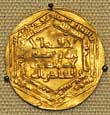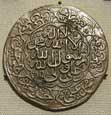

The Arabic inscription on the Umayyid coins reads: "In the name of God."
For the Byzantine coins, cf. American Numismatic Society, ANS 1968.131.99, weight 4.47 g.

Umayyad dynasty, AH 76/ CE 695-6, minted in Damascus. Weight: 4.030 g.; Dia.: 19 mm.
CM 1954.10-11.2
Cf. American Numismatic Society ANS 1970.63.1, weight 4.461 g., dia. 20 mm., dated 1694-5. On its reverse is the pillar (based on the Byzantine coin but with the cross bar removed).

Damascus, AH 77 and 78/CE 696-7, 697-8. Weight: 4.25 g.; Dia. 19 mm.
CM 1874.7-6.1
Cf. American Numismatic Society ANS 1917.215.3395, dated 1697-98.

Baghdad, AH 145/CE 762; AH 148/CE 765.
Cf. American Numismatic Society, ANS 1917.215.9, weight 4.257 g., dia. 19 mm., dated 754-755.



Contrast last two coins, pre-Islamic Sasanian silver dirhams, minted at Ardashir-Khurra, year 27 and Nihavand, Iran, year 30, i.e., CE 658, 661.
For no. (1), cf. American Numismatic Society, ANS 1001.57.4947, weight 2.883 g., dia. 25 mm.; for no. (2) (Herat) cf. ANS 1977.253.1, issued at Abarshahra (Khurasan/Nishapur), Iran, weight 2.82 g.; for no. (3), cf. ANS 1930.168.7, issued by Salm b. Qutayba at al-Basra (Iraq) AH 145/CE 762-3,

Tahirid dynasty, Samarkand, Uzbekistan, AH 209/CE 824.

Saffarid dynasty. Fars, Iran. AH 292/CE 905.
Cf. American Numismatic Society, ANS 1973.37.7, issued by Ahmad b. Muhammad at Andaraba, Tukharistan, AH 292/CE 904-905.

Samanid dynasty. Balkh, Afghanistan. AH 293/CE 906.

Samanid dynasty. (l.) Samarkand, AH 309/CE 921-2; (r.) Nishapur, AH 309/CE 921-22.
1974.9-16.468; 1974.9-16.567
Cf. American Numismatic Society, ANS 1971.104.97, issued by Nasr b. Ahmad al-Muqtadir in Samarkand, AH 304/CE 916-917, weight 3.07 g., dia. 26-27 mm.

Samanid dynasty. Al-Ma'dan, Afghanistan. No date, ca. 976-997.
Cf. two other issues of Samanid ruler Nasr (Nuh) II, from Kurat Badakhshan, Afghanistan, which have name of local governor al-Harath, 11.590 g., 1.7 cm, CM 1972.11-9.2.


Qarakhanid dynasty. (1) Uzkand, Uzbekistan, AH 394/CE 1004); (2) Bukhara, Uzbekistan, AH 427/CE 1036.
For no. (1) cf. American Numismatic Society ANS 2000.32.3, issued by Ahmad b. 'Ali/Nasr b. 'Ali at Uzkand, AH 394/CE 1003/1004, weight 2.795 g., dia. 25 mm.

Buried ca. 905, Cuerdale, Lancashire, England. The largest Viking hoard found in Western Europe, contained 7500 coins and 1500 other silver objects.
Read about the Cuerdale Hoard.

Deposited on Island of Gotland, Baltic Sea, 10th-11th c. CE.

Buyid dynasty. Rayy (Muhammadiyah), Iran, AH 398/CE 1008.

Ghurid dynasty. Ghazna, Afghanistan, AH 602/CE 1205.
Cf. American Numismatic Society, ANS 1922.216.7, issued by Mu'izz al'Din Muhammad, weight 20.1 gr., dated AH 600/CE 1203-1204.

Khwarazm shahs. Samarkand, Uzbekistan, AH 610/CE 1213.

Mongol great khans. Balkh, Afghanistan, AH 618/CE 1221.
Contrast American Numismatic Society, ANS 1998.25.687, issued by Chingiz Khan in Khurasan, ca. 1221-1227, weight 4.127 g., dia. 16 mm.

Saljuq dynasty. Siwas, Turkey, AH 63x/ca. CE 1237-1241.
Cf. American Numismatic Society, ANS 1922.211.171, issued by Kay-Khusraw II al-Mustansir at Siwas, AH 640/CE 1242, weight 2.92 g., dia. 23 mm.

Muwahhid dynasty. Sabta (Ceuta), Spain. No date, ca. CE 1248-1266.
Cf. American Numismatic Society, ANS 1917.215.626, issued by Abu Hafs 'Umar, weight 4.573 g., dia. 30 mm.

Mongol Ilkhanid dynasty. Shiraz, Iran, AH 700/CE 1301.

Timurid dynasty. Astarabad, Iran, AH 789/CE 1387.

Timurid dynasty. Herat, Afghanistan, no date, ca. CE 1390-1402.

Delhi sultanate, India. AH 947/CE 1540.

Safavid dynasty. Isfahan, Iran, AH 1118/CE 1706.

Kokand, Uzbekistan. AH 1252/CE 1836.